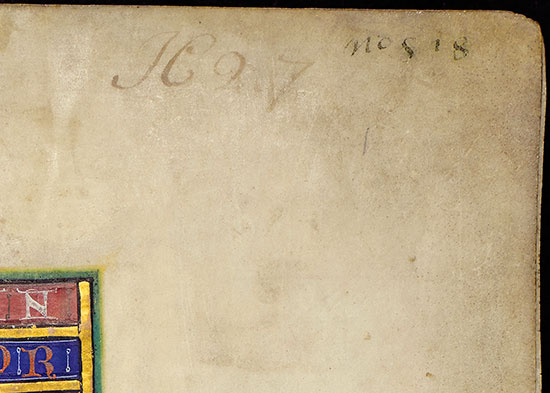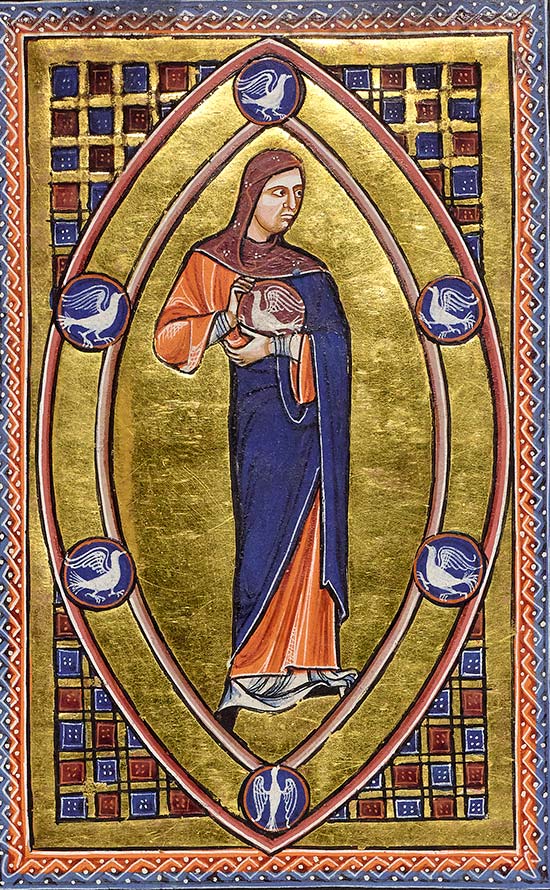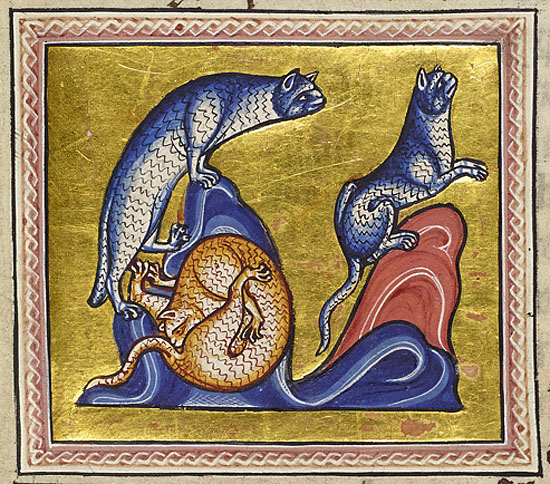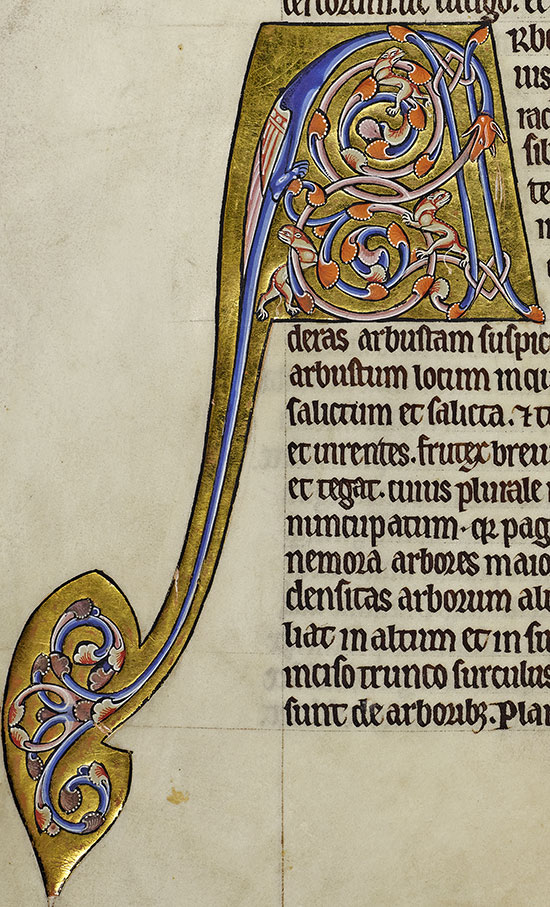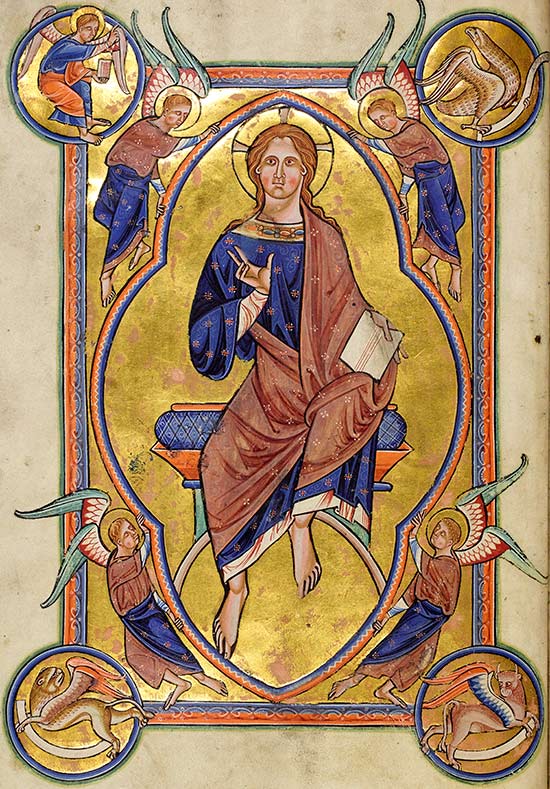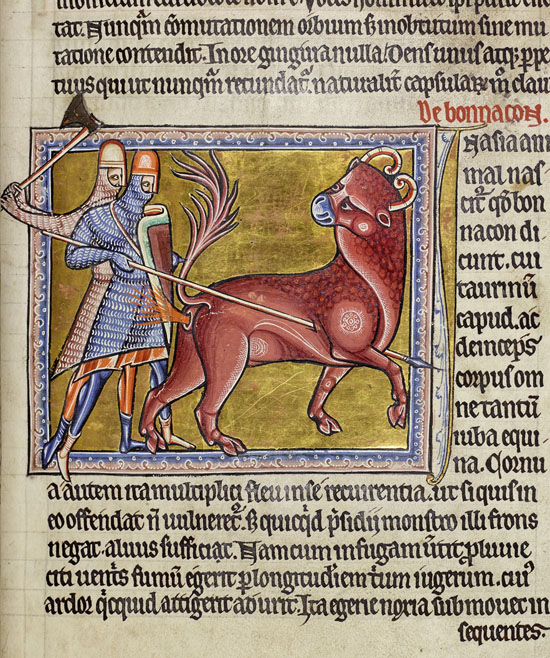Patrons of the Luxury Bestiaries at the End of the Twelfth Century
Evidence from the Aberdeen Bestiary alone cannot reveal its patron. Muratova (1986, 118-144) uses cumulative information from the group of related manuscripts to suggest a provenance in the north-east Midlands. Clark (2006, 68-71) makes a case for a south-eastern provenance.
The earliest painted bestiaries, New York Pierpont Morgan MS 81 and St Petersburg Russian National Library Q.v.V.1, are sister manuscripts whose artists clearly knew each other’s work. The Morgan Bestiary has an inscription saying that Philip Apostolorum gave the bestiary, a map of the world and many other books to Worksop Priory in 1187, for the edification of the monks. Philip was a canon of Lincoln Cathedral, mentioned in records between 1160 and 1203. The gift of his own manuscripts to the Augustinian house of Worksop indicates both the high level of culture at Lincoln and the general interest in the natural world prevalent in the northern provinces. Under its bishops Geoffrey Plantagenet, Walther of Coutances and St Hugh, Lincoln Cathedral developed a cathedral school renowned for its theological studies in the later part of the twelfth century. The art of the sermon was taught and bestiary imagery was frequently used to illuminate theological principles. The master and later cathedral chancellor William de Montibus uses many animal metaphors in his Summa (Paris, Bib. Mazarine MS 744(495)). He came to Lincoln in the late 1180s. The austere Cistercians, who would not have approved of the luxurious illustrations, none the less made use of animal stories for their moral teaching. St Aelred of Rievaulx in Yorkshire (abbot 1147-67) and Abbot Gilbert of Swineshead (d.1172) in Lincolnshire wrote many sermons based on Physiologus (Morson 1936, 146ff).
The bestiary or Physiologus was clearly important in the orbit of York Minster too. Various parish churches in the vicinity have small carvings on their portals illustrating animal stories but the most significant example is at Alne, near York. Here 19 motifs from Physiologus are carved in an orderly fashion around the doorway. Each story is in a frame and, most unusually, has its title carved beneath. The use of inscriptions in such a situation where most of the viewers would be illiterate strongly indicates that the carvings were copied from a book and in fact their designs are similar to those in Oxf. Bod. Laud Misc. 247 (Muratova, 1987, 337-353).
Geoffrey Plantagenet provides a connection between the bestiary interests of both York and Lincoln. He was the illegitimate son of King Henry II and therefore half-brother to Kings Richard and John. While he was Bishop of Lincoln (1173-82) he considerably developed the reputation of the cathedral school. He went on to become Archbishop of York (1189-1212). He owned the St Louis Psalter (Leiden U.L. MS 76A. Morgan 1982, 60-1), a manuscript of regal splendour whose calendar indicates that it was made for an Augustinian house in the north of England, most likely in York. Its style is very close to that of the Ashmolean and Aberdeen Bestiary (the curled up cat on Aberdeen f.23v is in an almost identical gymnastic position as Leiden f.120) and the psalms are illustrated with a profusion of animal subjects, quite unrelated to the text. Geoffrey was exiled to France losing much of his property in 1207 so presumably his opportunities to commission books came before his departure.
There are a number of other manuscripts illustrated in a style related to the Aberdeen and Ashmolean Bestiaries. They all have connections with Yorkshire and Lincolnshire in the late twelfth century but only the Guthlac Roll can be tied to a specific monastery, Croyland Abbey. The Guthlac Roll (B.L.Harley Roll Y.6. Morgan 1982, 67) consists of pen drawings in roundels, illustrating the life of St Guthlac of Croyland, Lincolnshire. They look rather like patterns for stained glass windows and indeed the glass in the window of the North Rose at Lincoln Cathedral is in a similar style. The artist of the Guthlac Roll may perhaps have produced the drawings in the Cambridge Bestiary (U.L. Ii 4.26. Morgan 1982, 66) because they are so alike in appearance. The paintings in the St Petersburg and Pierpont Morgan Bestiaries are closely related to this Lincolnshire style. The Copenhagen Psalter (Copenhagen Bib. Roy. Thott 14 32) whose calendar indicates a northern Augustinian house shares a great deal of its delicacy, in particular the white highlights, with the Aberdeen Bestiary. These highlights can be seen on the ibex f.11r and the bonnacon f.12r. Both the Aberdeen and Ashmole Bestiaries (and their three dependents Cambridge, Gonville and Caius College MS 372/621; Oxford, Bodleian MS Douce 151; Oxford Bodleian University College MS 120) reproduce an exceptional amount of the Aviarium, using more of its text than other contemporary bestiaries (Clark, 2006, 26). As the Aviarium was written specifically as a moral and theological guide for Augustinian canons, the strong emphasis on this particular text could suggest an origin in an Augustinian house, and an Augustinian destination for the books. The three illuminations pasted into British Library MS Arundel 104, ff. 350r, 354r, 364v show many similarities to the Aberdeen artist, in particular the facial style, limbs and drapery, including the pattern of three dots found on Christ’s robe at the crucifixion.
Clark (1992, 80-85) argues for a south English origin. The general appearance of the Aberdeen style is quite widespread across England at the end of the twelfth century. Similar figures are found in the Decretum from St. Bertin at St. Omer in north-east France ( St Omer Bibl. Mun. 476) and a leaf associated with Canterbury ( B.L. Cott. Vesp.A.1). White filigree highlights are frequently found in southern manuscripts from Bury St. Edmunds and Canterbury (Kauffmannn,1975, nos. 56,68,70,96). Although Lincoln and York were distinguished centres of learning there is surprisingly little evidence for the production of luxury manuscripts there. Although it can be shown that bestiaries were studied in the north, they were equally popular in the south. The two monastic libraries at Canterbury held altogether seven bestiaries in the middle ages: elsewhere, if they are mentioned at all, medieval libraries usually had only one or two. Lastly, Clark points out that Aberdeen initials type 2 are similar to the Paris Psalter made in Canterbury (Paris, Bibl. Nat. MS lat 8846) and some of the glass in the Becket Window, Trinity Chapel at Canterbury is similar in style to the Aberdeen and Ashmole Bestiaries (Caviness 1981, pl.117).
Ultimately, most of this evidence is circumstantial. Within this group of bestiaries only St Petersburg can be located, as a gift from Lincoln to Worksop. Even this does not prove it was made in Lincoln. The Guthlac Roll is closely tied to Croyland, Lincolnshire and the St Louis Psalter comes from the north of England. The specific source of the Aberdeen Bestiary remains unknown.

